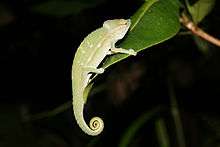Chamaeleoninae
Chamaeleoninae is the nominotypical subfamily of chameleons (family Chamaeleonidae). The Family Chamaeleonidae was divided into two subfamilies, Brookesiinae and Chamaeleoninae, by Klaver and Böhme in 1986.[1] Since its erection in 1986, however, the validity of this subfamily designation has been the subject of much debate,[2] although most phylogenetic studies support the notion that the pygmy chameleons of the subfamily Brookesiinae are not a monophyletic group.[3][4][5][6] While some authorities have previously preferred to use the subfamilial classification on the basis of the absence of evidence principal,[2] these authorities later abandoned this subfamilial division, no longer recognizing any subfamilies with the family Chamaeleonidae.[7] In 2015, however, Glaw reworked the subfamilial division by placing only the genera Brookesia and Palleon within the Brookesiinae subfamily, with all other genera being placed in Chamaeleoninae.[8]
| Chamaeleoninae | |
|---|---|
 | |
| Perinet chameleon (Calumma gastrotaenia) | |
| Scientific classification | |
| Kingdom: | Animalia |
| Phylum: | Chordata |
| Class: | Reptilia |
| Order: | Squamata |
| Suborder: | Iguania |
| Family: | Chamaeleonidae |
| Subfamily: | Chamaeleoninae Klaver & Böhme, 1986 |
Classification
The ten previously recognised genera in the subfamily are:
- Genus Archaius
- Genus Bradypodion
- Genus Calumma
- Genus Chamaeleo
- Genus Furcifer
- Genus Kinyongia
- Genus Nadzikambia
- Genus Rieppeleon
- Genus Rhampholeon
- Genus Trioceros
Trioceros was previously considered to be a subgenus of Chamaeleo, until Tilbury & Tolley (2009) raised it to full genus. Since then, two new species have been described in the genus Trioceros, by Krause & Böhme (2010), and Stipala et al. (2011). These two new species have not been published in combination with the generic name Chamaeleo, which poses a problem for the citation of these names in Wikipedia, unless Trioceros is treated as a full genus, following Tilbury & Tolley (2009).
Footnotes
- Klaver C, Böhme W (1986). "Phylogeny and classification of the Chamaeleonidae (Sauria) with special reference to hemipenis morphology". Bonner Zoologische Monographien. 22: 1–64.
- Tilbury, Colin (2010). Chameleons of Africa, An Atlas including the chameleons of Europe, the Middle East and Asia. Frankfurt: Edition Chimaira.
- Townsend T, Larson A (2002). "Molecular phylogenetics and mitochondrial genomic evolution in the Chamaeleonidae (Reptilia, Squamata)". Molecular Phylogenetics and Evolution. 23: 22–36. doi:10.1006/mpev.2001.1076. PMID 12182400.
- Raxworthy CJ, Forstner MRJ, Nussbaum RA (2002). "Chameleon radiation by oceanic dispersal" (PDF). Nature. 415: 784–787. doi:10.1038/415784a. PMID 11845207.
- Townsend TM, Tolley KA, Glaw F, Böhme W, Vences M (2011). "Eastward from Africa: Palaeocurrent-mediated chameleon dispersal to the Seychelles islands". Biological Letters. 7: 225–228. doi:10.1098/rsbl.2010.0701. PMC 3061160. PMID 20826471.
- Tolley KA, Townsend TM, Vences M (2013). "Large-scale phylogeny of chameleons suggests African origins and Eocene diversification". Proceedings of the Royal Society B. 280: 20130184. doi:10.1098/rspb.2013.0184. PMC 3619509. PMID 23536596.
- Tilbury, Colin (2014). "Overview of the Systematics of the Chamaeleonidae". In Tolley, Krystal A.; Herrel, Anthony (eds.). The Biology of Chameleons. Berkeley: University of California Press. pp. 151–174. ISBN 9780520276055.
- Glaw, F. (2015). "Taxonomic checklist of chameleons (Squamata: Chamaeleonidae)". Vertebrate Zoology. 65 (2): 167–246.
References
- Krause P, Böhme W. 2010. A new chameleon of the Trioceros bitaeniatus complex from Mt. Hanang, Tanzania, East Africa (Squamata: Chamaeleonidae). Bonn zoological Bulletin 57 (1): 19–29. ISSN 2190-7307 PDF
- Stipala J et al. 2011. A new species of chameleon (Sauria: Chamaeleonidae) from the highlands of northwest Kenya. Zootaxa, 3002: 1–16. Preview
- Tilbury CR, Tolley KA. 2009. A re-appraisal of the systematics of the African genus Chamaeleo (Reptilia: Chamaeleonidae). Zootaxa, 2079: 57–68. Abstract & excerpt